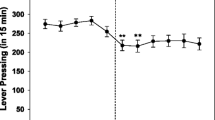Abstract
Rationale: Rats exhibit marked individual differences in consumption of freely available sucrose; however, the underlying mechanism(s) contributing to such interindividual differences remain unclear. Objectives: The current study examined whether: 1) motivational differences (as reflected by the degree of operant output to procure sucrose reward) underlie variability in sugar consumption, and 2) whether potential differences in dopaminergic and/or opioidergic systems contribute to such differences. Methods: In the initial experiment, Sprague-Dawley rats were divided into those that spontaneously consumed High or Low amounts of sucrose, based on the consumption of freely available sugar (±2 SD from group median) over 7 consecutive test days. The potential differences in their motivation to seek and "earn" sucrose solution rewards were measured using the progressive ratio (PR) schedule of reinforcement. Results: Performance of both groups on the PR schedule was sensitive to the concentration of sucrose (i.e. the higher the concentration, the greater the behavioral output). Furthermore, the High sucrose consumers earned a greater number of reinforcements (20% sucrose solution) than the Low group. Parenthetically, the degree of behavioral output by the High (but not the Low) group was comparable to that emitted for water under water-deprived condition. Treatment with the opioid antagonist, naloxone, attenuated PR performance for sucrose, whereas d-amphetamine (0.5 mg/kg) enhanced it. Furthermore, naloxone attenuated amphetamine-enhanced responding for sucrose reward, suggesting an interaction between the dopaminergic and opioidergic systems in the mediation of sucrose reward. Conclusions: These results support the contention that motivational differences may partially account for individual variability in sucrose consumption, and that dopaminergic and/or opioidergic agents differentially affect the "wanting" and/or "liking" of sucrose in the High and Low sucrose consumers.
Similar content being viewed by others
Author information
Authors and Affiliations
Additional information
Electronic Publication
Rights and permissions
About this article
Cite this article
Brennan, K., Roberts, D., Anisman, H. et al. Individual differences in sucrose consumption in the rat: motivational and neurochemical correlates of hedonia. Psychopharmacology 157, 269–276 (2001). https://doi.org/10.1007/s002130100805
Received:
Accepted:
Published:
Issue Date:
DOI: https://doi.org/10.1007/s002130100805




